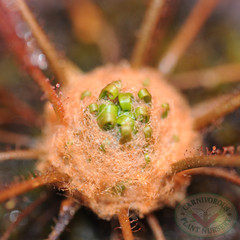
Dormancy in Carnivorous Plants
Dormancy in Carnivorous Plants
Many carnivorous plants are native to temperate climates (zones 3-8) and require a dormancy period over winter. Carnivorous plant dormancy is a natural protective mechanism that allows plants to survive an extended period of cold and dark. Some carnivorous plants, like the sundews, form winter buds. Others, like the Venus Flytrap and pitcher plants, form winter leaves. Some simply drop their leaves. It's a common mistake for the new grower to confuse dormancy with plant death or disease.
Dormancy is triggered by cooler nights and shorter days in the fall. Though young carnivorous plants (less than three years old) can go without dormancy, it is required in mature temperate carnivorous plants. Without it, they will slowly dwindle, becoming less vigorous. This weaker growth often leads to a flowering that pulls all the strength from the plant and kills it, or the plant succumbs to disease. If carnivorous plants are not allowed to rest, they will exhaust their energy and die. Tropical carnivorous plants do not require dormancy.
So, how do you care for carnivorous plants in the winter? When the plants begin to show signs of dormancy, water them less. Leave the soil only slightly damp, but never dry. If you are growing species native to your region outdoors no special action is required besides protecting your plants from the most extreme cold. See our page on over-wintering carnivorous plants. If growing temperate species indoors, it's important to provide an extended cool period. I like to target a minimum of 45 days at 45°F (7°C).You can keep them cool for 3 to 6 months, depending upon their native area. This can be done by placing them in the basement, garage or on a frost-free porch. A refrigerator is fine; just be careful not to freeze them. Carnivorous plants do not require light during dormancy and darkness will not harm them.
Woodland ephemerals like Cypripedium (Lady's Slipper), Arisaema (Jack-in-the-pulpit), Dicentra (Dutchman's Breeches and Squirrel Corn), Trillium, Erythronium (Trout Lily) and Hepatica bloom in mid-Spring and then recede. They lose most or all of their foliage as the weather warms in late Spring and early Summer and enter dormancy through the heat of Summer and cold of Winter, re-emerging the following Spring.
Temperate Sundews like Drosera filiformis, D. intermedia, and D. rotundifolia form a winter hibernaclua. It resembles a fuzzy round button with tightly curled leaves in the center. Some are less hairy than others, but the tight cluster resembles a tiny set of coiled fern fronds.
Dormant Drosera filiformis. Courtesy B. Smith.
The same D. filiformis months later. Courtesy B. Smith.
Venus Flytraps produce smaller and smaller traps as Fall approaches Winter. During Venus Flytrap dormancy, the old traps die, turn black and form a ring of old dead traps around the tight, small cluster of traps. In extreme cold all the traps may die back at ground level and the bulb will overwinter underground. New traps emerge once temperatures are above 55°F (12°C).
Sarracenia often keep their tube traps for two years, but the onset of Winter does trigger dormancy. The tops of the hoods start to wither, dry and brown. This drying works its way down the tube, which eventually dies. Often the lower third of the traps stay green throughout the Winter, as the plant continues to absorb nutrients from the summer's catch.
Temperate Butterworts will form tight small winter buds of very short stout waxy leaves at the onsight of cool weather. They will overwinter in this state, and begin normal growth, once Spring temperatures rise.
Bladderworts and Aldrovanda from turions. These are tight bud-like clusters at the tips of the plant that become quite dense. As the lower part of the plant dies, the turions sink to the bottom and overwinter. As Spring temperatures rise and the turion begins to grow, the plant floats to the surface and begins full growth again.




